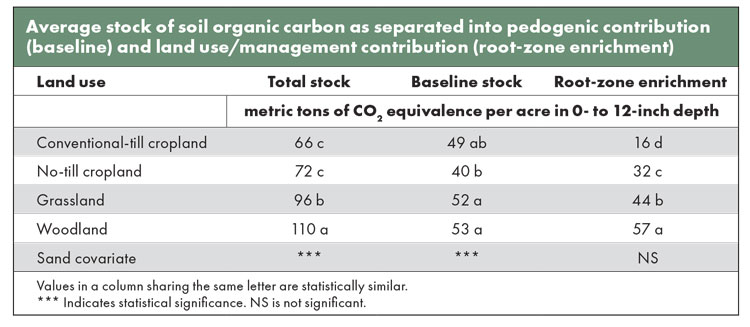
Organic matter is a key indicator of soil health and soil function, affecting the natural supply of nutrients, buffering against pH changes, softening soil to resist compaction, holding more water for plant uptake, creating water-stable aggregates to resist erosion, and providing organic resources to feed soil biological communities.
Another big reason for attention on soil organic matter these days is the possibility of sequestering some of the carbon dioxide (CO2) in the atmosphere as organic matter in soil. Soil organic matter is mostly composed of carbon — 58% by weight on average. A reasonably fertile agricultural field will contain about 3% organic matter in the top 6 inches of soil. With a bulk density of 1.3 grams per cubic centimeter, this furrow slice of soil would contain 50 metric tons of CO2 equivalence per acre. To a depth of 12 inches, this fertile soil might reasonably hold 80 metric tons of CO2 per acre, since soil organic carbon concentration naturally declines with soil depth.
Many influential factors
On a global scale, temperature and moisture have the largest influence on the amount of soil organic carbon. Lower mean annual temperature leads to less decomposition, resulting in accumulation of soil organic carbon over centuries. Greater mean annual precipitation allows for greater plant production, resulting in greater carbon input to soil. However, it is the balance of photosynthetic production and microbial decomposition that determines the net change in soil organic carbon.

Other contributing factors affecting the balance of soil organic carbon are soil texture, depth of rooting, type of soil minerals, soil pH, soil microbial composition, plant species composition, and soil disturbance. Many of these factors influence either plant production potential or soil microbial activity, which are the two opposing yet necessary forces that transform plant and animal residues into soil organic matter. These are generalizable factors, but local conditions may alter the net influence of any one of these factors.
Multiple agricultural research stations across North Carolina were recently sampled to assess how land use affects soil organic matter. A total of 310 fields were sampled on 25 research stations. Root-zone enrichment of soil organic carbon is a new calculation procedure that was used to separate the influence of recent management from that of historical soil formation (pedogenesis). The full scientific paper can be accessed at https://www.jswconline.org/content/78/2/124.
Land decisions impact carbon
Soil depth had the largest influence on soil organic matter and was followed by land use and physiographic region. Depth stratification was strongest in woodland and grassland management systems. In the surface 6 inches, soil organic matter was often lowest under conventional-till cropland (2.5%) because frequent tillage promotes greater decomposition. No-till cropland had slightly elevated soil organic matter (2.7%) due to less soil disturbance.
Grassland had even greater soil organic matter (4.2%) because of permanent ground cover and roots that protected soil. With minimal traffic and lack of soil disturbance, woodland had the greatest soil organic matter (6.0%). However, soil organic nitrogen was greater under grassland than under woodland. The Piedmont and Coastal Plain regions had the lowest, and the Blue Ridge and Flatwoods regions had the highest soil organic matter.
With some reasonable assumptions, management-induced change in soil organic carbon could be separated from a baseline condition in each field. Baseline soil organic carbon can be attributed to pedogenesis, while root-zone enrichment of soil organic carbon can be attributed to the past half-century of land use and management.
Conservation land use led to greater soil organic carbon accumulation. Coarse-textured soils tended to have lower carbon stocks than fine-textured soils, but this was pedogenic influenced only. This is indicated by the significant sand covariate in the baseline stock, which influenced the total stock. However, the influence of conservation management to enhance soil organic carbon was independent of soil texture.
Land management has a large role to play in soil organic carbon storage, even in the southeastern U.S. where soils are inherently low in organic matter. Building soil organic matter requires us to start at the soil surface, and grasslands are a highly effective approach in this process.
This article appeared in the November 2023 issue of Hay & Forage Grower on page 29.
Not a subscriber? Click to get the print magazine.

